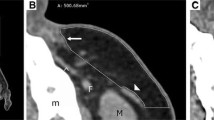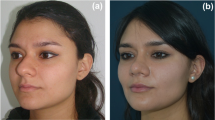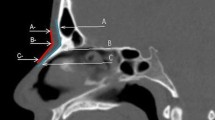Abstract
Background
The changes that occur to midfacial fat with increasing age and BMI are poorly understood. The aim of this study was to determine how superficial cheek fat volume and distribution are differentially predicted by changes in BMI versus age.
Methods
We conducted a retrospective observational study of patients with facial computed tomography scans. Superficial cheek fat volumes were measured, and multiple linear regression analysis was performed to model the relationships between cheek fat and corresponding sex, age, and BMI data.
Results
A total of 109 patients were included in our analysis (51 male, 58 female). The subjects’ ages ranged from 21.7 to 91.1 years with a mean (SD) age of 59.7 (15.0) years. The mean (SD) superficial cheek volume of the subjects was 10.46 (2.57) cc. Female subjects had a significantly greater mean total superficial cheek fat volume compared to male subjects (11.18 cc vs. 9.64 cc; P < 0.001). The results of multiple linear regression analysis indicated that together, age, sex, and BMI explained 50.8% of the variance in cheek fat volumes (R2 = 0.51, P < 0.001). BMI significantly predicted total cheek fat volume (β = 0.239, P < 0.001), in addition to age (β = 0.029, P < 0.017) and sex (β = − 1.183, P = 0.001; female = 0, male = 1). Age predicted the greatest gain of fat in the caudal subdivision of cheek (β = 0.015, P < 0.001), whereas BMI predicted the greatest gain in the cephalad subdivision (β = 0.106, P < 0.001).
Conclusions
Age, sex, and BMI are important predictors of midfacial fat volume. This study shows that increases in age and BMI differentially predict the distribution of superficial cheek fat.
Level of Evidence IV
This journal requires that authors assign a level of evidence to each article. For a full description of these Evidence-Based Medicine ratings, please refer to the Table of Contents or the online Instructions to Authors www.springer.com/00266.



Similar content being viewed by others
References
Stuzin JM, Baker TJ, Gordon HL (1992) The relationship of the superficial and deep facial fascias: relevance to rhytidectomy and aging. Plast Reconstr Surg 89:441–449 (discussion 450-441)
Lambros V (2007) Observations on periorbital and midface aging. Plast Reconstr Surg 120:1367–1376 (discussion 1377)
Rohrich RJ, Pessa JE (2007) The fat compartments of the face: anatomy and clinical implications for cosmetic surgery. Plast Reconstr Surg 119:2219–2227 (discussion 2228-2231)
Rohrich RJ, Pessa JE, Ristow B (2008) The youthful cheek and the deep medial fat compartment. Plast Reconstr Surg 121:2107–2112
Schaverien MV, Pessa JE, Rohrich RJ (2009) Vascularized membranes determine the anatomical boundaries of the subcutaneous fat compartments. Plast Reconstr Surg 123:695–700
Wan D, Amirlak B, Rohrich R, Davis K (2013) The clinical importance of the fat compartments in midfacial aging. Plast Reconstr Surg Glob Open 1:e92
Gerth DJ (2015) Structural and volumetric changes in the aging face. Facial Plast Surg 31:3–9
Pessa JE (2000) An algorithm of facial aging: verification of Lambros’s theory by three-dimensional stereolithography, with reference to the pathogenesis of midfacial aging, scleral show, and the lateral suborbital trough deformity. Plast Reconstr Surg 106:479–488 (discussion 489-490)
Paskhover B, Durand D, Kamen E, Gordon NA (2017) Patterns of change in facial skeletal aging. JAMA Facial Plast Surg 19:413–417
Mendelson BC, Hartley W, Scott M, McNab A, Granzow JW (2007) Age-related changes of the orbit and midcheek and the implications for facial rejuvenation. Aesthet Plast Surg 31:419–423
Shaw RB Jr, Kahn DM (2007) Aging of the midface bony elements: a three-dimensional computed tomographic study. Plast Reconstr Surg 119:675–681 (discussion 682-673)
Mendelson B, Wong CH (2012) Changes in the facial skeleton with aging: implications and clinical applications in facial rejuvenation. Aesthet Plast Surg 36:753–760
Gierloff M, Stohring C, Buder T, Gassling V, Acil Y, Wiltfang J (2012) Aging changes of the midfacial fat compartments: a computed tomographic study. Plast Reconstr Surg 129:263–273
Tower J, Seifert K, Paskhover B (2018) Longitudinal analysis of superficial midfacial fat volumes over a 10-year period. Aesthet Plast Surg 42:995–1001
Gosain AK, Klein MH, Sudhakar PV, Prost RW (2005) A volumetric analysis of soft-tissue changes in the aging midface using high-resolution MRI: implications for facial rejuvenation. Plast Reconstr Surg 115:1143–1152 (discussion 1153-1145)
Jang MS, Kim HY, Dhong HJ, Chung SK, Hong SD, Cho HJ (2015) An analysis of Asian midfacial fat thickness according to age group using computed tomography. J Plast Reconstr Aesthet Surg 68:344–350
Wysong A, Joseph T, Kim D, Tang JY, Gladstone HB (2013) Quantifying soft tissue loss in facial aging: a study in women using magnetic resonance imaging. Dermatol Surg 39:1895–1902
Wysong A, Kim D, Joseph T, MacFarlane DF, Tang JY, Gladstone HB (2014) Quantifying soft tissue loss in the aging male face using magnetic resonance imaging. Dermatol Surg 40:786–793
Sarin S, Wenger C, Marwaha A et al (2008) Clinical significance of epicardial fat measured using cardiac multislice computed tomography. Am J Cardiol 102:767–771
Marwan M, Achenbach S (2013) Quantification of epicardial fat by computed tomography: why, when and how? J Cardiovasc Comput Tomogr 7:3–10
Becker M, Balague N, Montet X et al (2015) Hyaluronic acid filler in HIV-associated facial lipoatrophy: evaluation of tissue distribution and morphology with MRI. Dermatology 230:367–374
Author information
Authors and Affiliations
Corresponding author
Ethics declarations
Conflict of interest
The authors declare that they have no conflict of interest.
Rights and permissions
About this article
Cite this article
Tower, J.I., Seifert, K. & Paskhover, B. Patterns of Superficial Midfacial Fat Volume Distribution Differ by Age and Body Mass Index. Aesth Plast Surg 43, 83–90 (2019). https://doi.org/10.1007/s00266-018-1249-0
Received:
Accepted:
Published:
Issue Date:
DOI: https://doi.org/10.1007/s00266-018-1249-0




